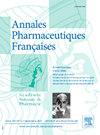Metabolomic analysis of 18th–19th pipes from the kingdom of Dahomey (actual Benin) indicates smoking of caffeine-bearing plants
IF 1.1
Q4 PHARMACOLOGY & PHARMACY
引用次数: 0
Abstract
Increasingly, molecular chemistry and pharmacology are complementing classical studies in the field of archaeology. In this case, we present the results of the chemical study of pipe residues found in the context of an archaeological mission (AROMA mission: Archaeology of the Exercise of Royal and Magico-Religious Power) in the royal palaces of Abomey (Benin), dating from the 17th-19th century. The search for many products was carried out (mainly tobacco, cannabis) but surprisingly only highlighted the presence of caffeine residues. This result is discussed and compared with field notions and in particular with ethnological surveys where coffee was consumed in the old way, smoked in a pipe (peripheral part or shell, and not the bean itself or the leaves).
De plus en plus, la chimie moléculaire et la pharmacologie viennent compléter les études classiques dans le domaine de l’archéologie. Dans le cas présent, nous présentons les résultats de l’étude chimique de résidus de pipes retrouvés dans le cadre d’une mission archéologique (mission AROMA : Archéologie de l’exercice du pouvoir royal et magico-religieux) dans les palais royaux d’Abomey (Bénin), datant du XVIIe–XIXe siècle. La recherche de nombreux produits a été effectuée (essentiellement du tabac, du cannabis) mais n’a mis en évidence que la présence de résidus de caféine. Ce résultat est discuté et comparé aux notions de terrain et notamment aux enquêtes ethnologiques où le café était consommé à l’ancienne, fumé dans une pipe (partie périphérique ou coque, et non le grain lui-même ou les feuilles).
来自达荷美王国(实际的贝宁)的18 -19支烟斗的代谢组学分析表明,吸食含咖啡因的植物。
分子化学和药理学正日益成为考古学领域经典研究的补充。在这种情况下,我们介绍了在考古任务(AROMA 任务)中发现的烟斗残留物的化学研究结果:在阿波美(贝宁)王宫中发现的烟斗残留物的化学研究结果。对许多产品(主要是烟草和大麻)进行了搜索,但令人惊讶的是只发现了咖啡因残留物。我们对这一结果进行了讨论,并将其与实地调查,特别是与用烟斗(外围部分或外壳,而不是咖啡豆本身或叶子)以古老方式饮用咖啡的人种学调查进行了比较。
本文章由计算机程序翻译,如有差异,请以英文原文为准。
求助全文
约1分钟内获得全文
求助全文
来源期刊

Annales pharmaceutiques francaises
PHARMACOLOGY & PHARMACY-
CiteScore
1.70
自引率
7.70%
发文量
98
期刊介绍:
This journal proposes a scientific information validated and indexed to be informed about the last research works in all the domains interesting the pharmacy. The original works, general reviews, the focusing, the brief notes, subjected by the best academics and the professionals, propose a synthetic approach of the last progress accomplished in the concerned sectors. The thematic Sessions and the – life of the Academy – resume the communications which, presented in front of the national Academy of pharmacy, are in the heart of the current events.
 求助内容:
求助内容: 应助结果提醒方式:
应助结果提醒方式:


